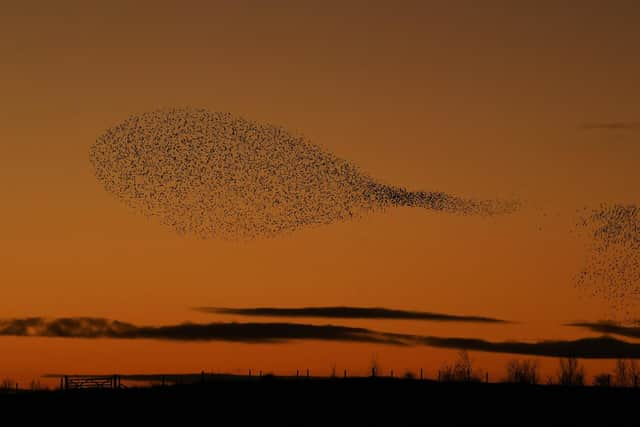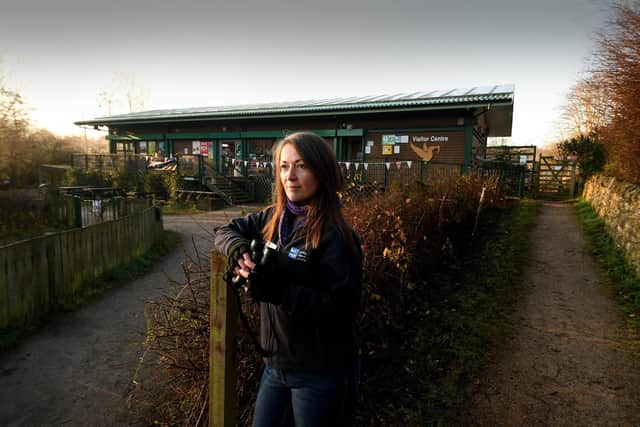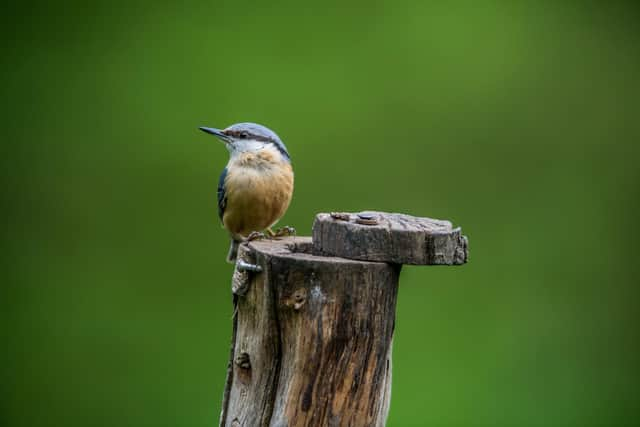Behind the scenes at Fairburn Ings Nature Reserve as birds go in search of food this winter
“People come to Fairburn to see lots of them – kingfishers, robins, nuthatches, curlews...”
Outside, robins, goldfinches, sparrows and more go flitting bush to bush to gobble from hanging feeders. “In winter, birds want high-fat foods, which reserves like Fairburn help provide,” says Jen. “They love berries, but our feeders are also stocked with nuts, seeds, and suet balls – packing energy.” As we sip our coffee in the warmer confines of the office, blue tits and blackbirds compete with hungry thrushes and a plucky nuthatch, skittering over branches to a feeder full of suet.
Advertisement
Hide AdAdvertisement
Hide AdBritain’s birds are threatened by climate change and habitat loss, but I was heartened to hear how reserves like Fairburn Ings, near Castleford, are helping to counter these threats. Jen and I took a walk around to see more of the reserve, which, built on old coalfields, has operated since 1957, and talked about the significance of winter for our birds.


“In winter, birds work harder to find food,” Jen tells me, as we pass the garden beside the visitor centre, a wren sifting through undergrowth. As temperatures drop, insects diminish. Thrushes, blackbirds, fieldfares and redwings will snaffle berries; secretive birds like wrens and dunnocks give predators the slip by avoiding tables and feeders – a tip for gardeners being to rotate these from time to time, lessening the likelihood of predators becoming familiar.
“Many birds spend more time in and around nests,” adds Jen, “but if it’s a territory issue, some are more active in winter.” Robins, for example, will investigate their localities, warning rival males with their deceptively chirpy song. Breeding doesn’t usually start until around March, but can begin as early as January, and it is in winter that we hear both males and females singing.
Robins are associated with winter, and in good numbers. The RSPB estimates there are 6,700,000 breeding pairs across Britain. Overall, though, it is a mixed picture for small birds. Milder winters mean birds like chiffchaff and blackcaps are increasingly wintering in Britain. Buzzards are booming, and winter birds fare better than their migratory cousins in terms of climate change’s impact.


Advertisement
Hide AdAdvertisement
Hide AdSevere winters are challenging, though. Many birds need to find food throughout daylight, requiring around 30 per cent of their body weight to survive cold nights, when some huddle together to conserve body heat. Hoarders like jays repair to “larders” stocked in autumn. Wrens track down hibernating insects among evergreen leaves of ivy.
Flocking increases the chances of locating food, and spotting predators, and no examples are more spectacular than flocking starlings – “murmurations” – which Jen tells me happen mostly between October and March. “Hopefully you’ll see one today,” she says. I hope so, too. But for now, we trudge on, along the aptly named, and muddy, “Riverside Trail”.
Reserves like Fairburn are great for wintering wildfowl, and passerines visiting from Scandinavia and Iceland. “Our reserves sometimes flood,” says Jen, “but the lakes rarely freeze. Even in a cold, wet winter, Yorkshire, compared to Greenland or Siberia, is almost tropical!”
We sit in a hide, watching black-headed gulls and goldeneye spool the rain-studded lake, with cormorants poised on reed “islands” in the darkening distance. A pontoon raft is visible. “Climate change causes fluctuating water levels, to the detriment of island nests – we lost some avocet nests last year,” says Jen. This raft, high enough to overcome rising water levels, will prove suitable for common terns especially.


Advertisement
Hide AdAdvertisement
Hide AdAfter watching a heron prowl a stream, we stroll by the old coal tips, restored to deciduous woodland, grassland and a lagoon. Jen acknowledges that, to some, habitat “management” represents interference, but stresses any management is proportionate to human-aggravated habitat loss or climate change. “At Fairburn, our land management reflects the needs of birds.”
Wet grasslands support waders like lapwings, redshanks and snipe. Fairburn also hosts curlews, teal and wigeon. Redpolls are seen in the alder trees, and Fairburn’s reedbed is being expanded for the benefit of birds such as breeding reed buntings and bitterns, as well as harvest mice and invertebrates.
“We nurture the environment. Willow tits are a success. They’re breeding successfully, with healthy populations.” Jen tells me.
Willow tits are Britain’s most rapidly declining resident birds – down by over 90 per cent since the 1970s, with fewer than 3,000 pairs. “There are many factors,” Jen says, “from drying soils –they like damp – to fragmented woodlands due to urbanisation. But Fairburn is bucking the national trend, not least thanks to lots of dead and decaying wood, and scrub.”
Advertisement
Hide AdAdvertisement
Hide AdWide areas of rewilded land with thickets of young trees are conducive to their survival, making Fairburn ideal. If you see one in your garden, it’s likely to be in winter, when invertebrates are scarcer in the countryside, and their attentions turn to berries, nuts and seeds.
Instrumental to the reserve’s hard work are fantastic volunteers like Duke of Edinburgh Award student Joseph Boyall, who has given up his Saturdays since August 2020. “I’d never been to Fairburn before,” Joseph tells me, as we chat in the reserve shop. “It’s a real change of scene from my regular job in a factory.” He has taken up birdwatching himself, and, having completed most of his studies, intends to continue volunteering for sheer enjoyment of the natural world.
I’ve heard many similar stories from volunteers before, but for anyone unable to venture far from home, Yorkshire’s winters still provide a diversity of birds. Every day in parks, gardens, train stations and city streets. I’ve seen crows, thrushes and yellow wagtails flashing up in streams, or jauntily jouncing along rooftops in the rain. Noticeable against leafless backgrounds are resident coal tits, great tits and blue tits – among the loveliest sights on a winter morning.
Goosanders glide canals and lakes, bullfinches bobble over branches, goldcrests twinkle in the treetops. The latter are a good example of birds whose numbers have risen with milder temperatures – more than 10 per cent since the 1960s – though their lives are not without challenges. Britain’s winter birds must contend with scarcer food, cold nocturnal temperatures, and threats like climate change, pollution and habitat depletion.
Advertisement
Hide AdAdvertisement
Hide AdHowever, their plight is aided by renewed public interest, careful feeding by gardeners, and reserves like Fairburn Ings, where the work of conservationists is complemented by the unflagging efforts of volunteers, giving up their time to give something back to the natural world.
Leaving the office, with dusk setting in, I take a last wander on my own, past the reedbeds and the kingfisher screen, and up towards the old coal tips. Looking up, I notice an unexpected moving shape, sweeping like a figure-of-eight.
Thirty metres long, it’s the most spectacular starling murmuration I’ve ever seen, a swirl of curling black, twisting and dipping like a thundercloud, swerving over treetops and blending into dark sky, a true highlight of what Yorkshire’s winter birdlife has to offer.
www.rspb.org.uk/reserves-and-events/reserves-a-z/fairburn-ings/
Comment Guidelines
National World encourages reader discussion on our stories. User feedback, insights and back-and-forth exchanges add a rich layer of context to reporting. Please review our Community Guidelines before commenting.
